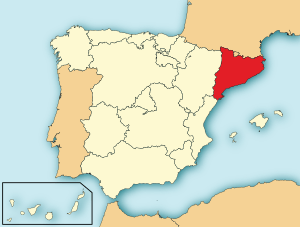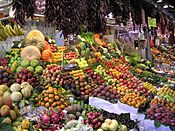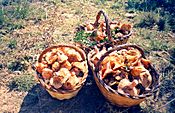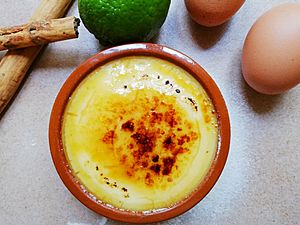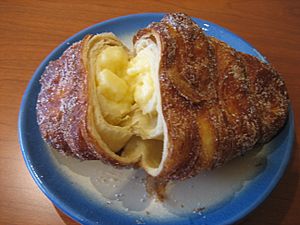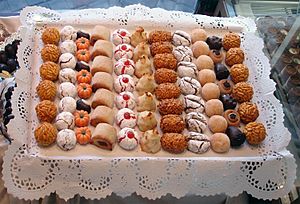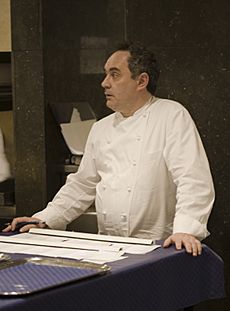Catalan cuisine facts for kids
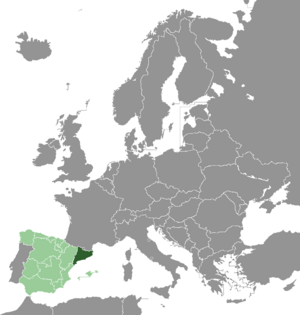
Catalan cuisine is the delicious food from Catalonia, a region in Spain. It's known for its fresh ingredients and tasty dishes. This cooking style is a big part of the wider Mediterranean cuisine, which focuses on healthy and flavorful foods.
Contents
History of Catalan Food
People in Catalonia have been writing down recipes for a long time! We know about several Catalan cookbooks from the Middle Ages. One very important book was the Llibre de Coch from 1520. It was a popular cookbook during the Spanish Renaissance.
This old book had many recipes for sauces. These sauces used interesting ingredients like ginger, nutmeg, cinnamon, and saffron. One sauce, Salsa de pagó, was named after the peacock (el paó). It was often served with poultry, especially during medieval Christmas meals. Another sauce, Salsa mirraust, was for poultry that was partly roasted. The sauce was made thick with egg yolks, toasted almonds, and breadcrumbs.
People also enjoyed Hippocras (called pimentes de clareya). This was a spiced wine made with cinnamon, cloves, ginger, pepper, and honey. It was filtered through a special cloth.
Main Ingredients in Catalan Cooking
Catalan food uses many ingredients popular around the Mediterranean Sea. These include:
- Fresh vegetables: especially tomatoes, garlic, eggplants, capsicums (peppers), and artichokes.
- Wheat products: like bread and pasta.
- Arbequina olive oils: a special type of olive oil.
- Wines.
- Legumes: such as beans and chickpeas.
- Mushrooms: especially wild ones.
- Nuts: like pine nuts, hazelnuts, and almonds.
- Pork: used in many ways, including sausage from Vic and ham.
- Sheep and goats' cheese.
- Poultry (like chicken), lamb.
- Many types of fish: such as sardines, anchovies, tuna, and cod.
Catalan cuisine is quite varied. Inland areas cook more pork dishes, as Catalonia makes a lot of pork products. Along the coast, you'll find more fish recipes. Sometimes, meat and seafood are mixed together in a special Catalan style called mar i muntanya, which means "sea and mountain." For example, you might find chicken with lobster or rice with both meat and seafood.
Many dishes also mix sweet and savory flavors. Stews often use botifarra (a type of pork sausage) and a special sauce called picada. Picada is made from ground almonds, hazelnuts, pine nuts, and sometimes garlic or herbs.
-
Fruits from La Boqueria Market, Barcelona
-
Rovellons or Pinatells, a tasty wild mushroom
Popular Savoury Dishes
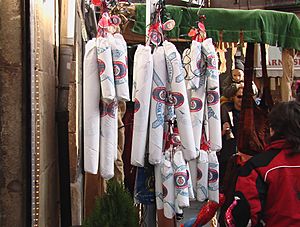
Here are some well-known savoury dishes from Catalonia:
- Catalan-style cod: Cod fish cooked with raisins and pine nuts.
- Escalivada: A dish made from various grilled vegetables.
- Escudella: A hearty stew. It can be served as a soup with pasta, or the soup is eaten first, followed by the meat and vegetables.
- Esqueixada: A refreshing salad made with salted cod, tomato, and onion.
- Mongetes amb botifarra: Beans served with pork sausage.
- Pa amb tomàquet: A very simple but popular dish of bread rubbed with tomato and olive oil. Sometimes garlic is added too.
- Savoury coca: A flatbread that can have different toppings, like vegetables or meat.
- Mar i muntanya dishes: These dishes combine meat and seafood, like chicken with lobster.
- Embotits: A general name for different kinds of cured pork meats, such as fuet (a dried sausage) and llonganissa (salami).
- Calçot: A special type of onion that is grilled and eaten during a "Calçotada" party.
- Caragols a la llauna: Snails cooked in a pan.
Tasty Sauces and Condiments
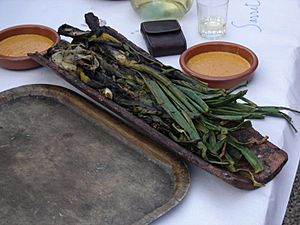
Catalan cuisine has some famous sauces that add a lot of flavor:
- Allioli: A thick sauce made from garlic and olive oil. It's often eaten with grilled meats or vegetables. The name means "garlic and oil" in Catalan.
- Samfaina: This sauce is similar to a French ratatouille or Spanish pisto. It's made with vegetables like tomatoes and peppers.
- Romesco: A rich sauce from Valls made with almonds, hazelnuts, garlic, bread, vinegar, tomatoes, olive oil, and dried red peppers.
- Xató: A sauce similar to Romesco but without tomatoes.
Sweet Treats and Desserts
Catalonia has many delicious desserts:
- Crema catalana: A famous yellow cream made with egg yolks, milk, and sugar. It's similar to a custard. It's often served in a small dish, with sugar sprinkled on top and then burned to create a crunchy, sugary layer.
- Mel i mató: A simple dessert of mató cheese served with honey.
- Xuixos: Fried pastries from Girona that are filled with crema catalana.
- Panellets: Small pastries made from pine nuts, almonds, and sugar. They come in different shapes and flavors. People eat them during la Castanyada on November 1st, which is similar to Halloween.
- Sweet coques: These flatbreads were traditionally eaten on holidays. There's a different coca for almost every holiday throughout the year.
- Mona de Pasqua: A special pastry given by godparents to their godchildren on Easter. It's decorated with almonds, chocolate eggs, and colorful designs. In the past, it would have one egg for each year of the child's age, up to twelve.
- Tortell: A round pastry often eaten after Sunday lunch with family or friends. It can be made with puff pastry and filled with cream or chocolate.
- Torró: A sweet treat made with almonds, especially popular at Christmas.
- Neules: Thin, crispy wafers eaten at Christmas, often dipped in cava (Catalan sparkling wine). They are similar to waffles.
Catalan Wines
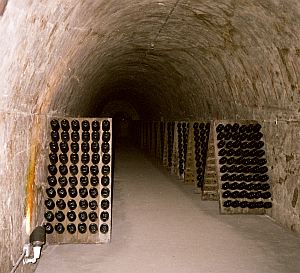
Catalonia has 11 special wine-growing regions. Some of the most famous are Priorat and Penedès.
- Cava: This is a sparkling wine, much like champagne, but it's from Catalonia! It's mostly made in the Alt Penedès and Anoia regions and is exported all over the world.
- Moscatell: A sweet Catalan wine. Unlike some other sweet wines, Catalan moscatell is usually thicker and is enjoyed after a meal, with or after dessert.
Famous Chefs and Restaurants
Catalan cooks and chefs are known around the world for their amazing skills. Many top restaurants are in Catalonia. For example, Barcelona has several restaurants with Michelin stars, which are a sign of excellent food. In 2009, the American TV network MSNBC even called Barcelona the best food city in the world!
The Province of Girona is home to some of the world's best restaurants. El Celler de Can Roca was named the best in the world in 2014 and 2015. Another famous restaurant, elBulli in Roses, was often ranked as the best in the world before it closed in 2011.
See also
 In Spanish: Gastronomía de Cataluña para niños
In Spanish: Gastronomía de Cataluña para niños


